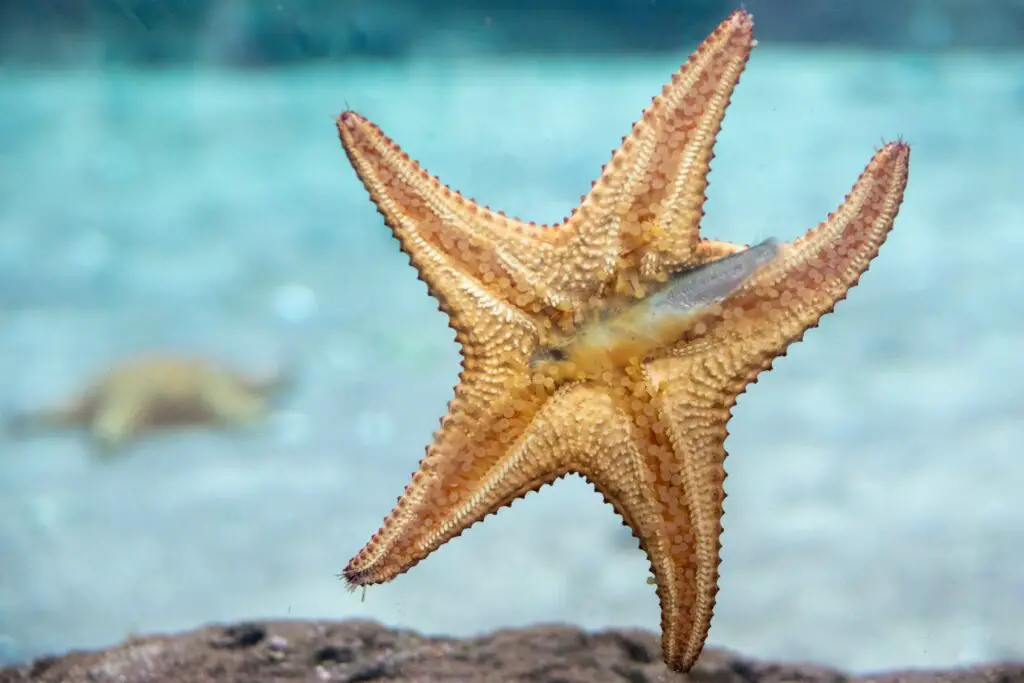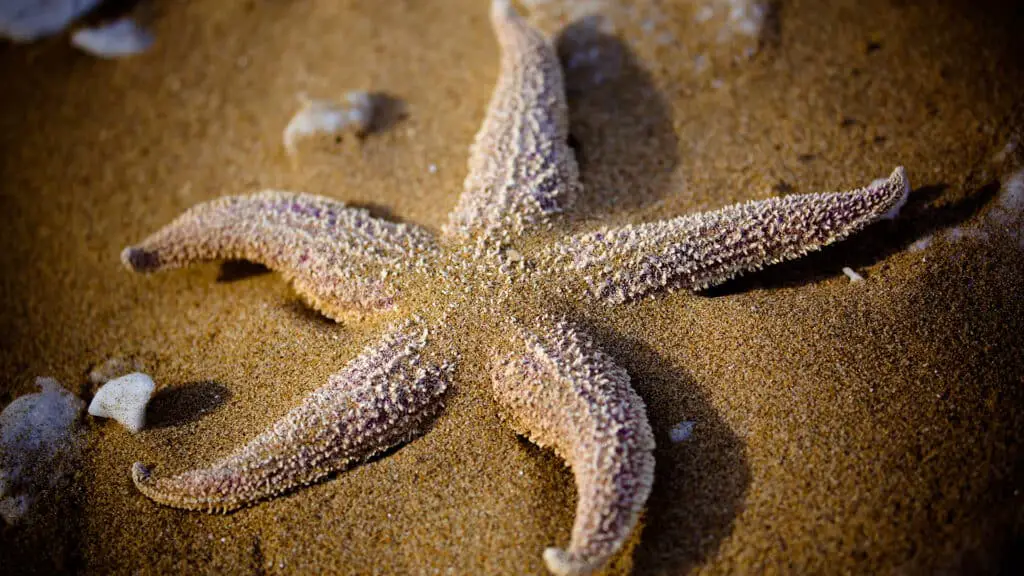What Is A Group Of Starfish Called

Introduction
What Is A Group Of Starfish Called: A group of starfish, scientifically known as “asteroids,” is commonly referred to as a “cluster,” “group,” or “aggregation” of starfish. These intriguing marine creatures are renowned for their distinctive appearance and fascinating behavior. Starfish are not actually fish; they belong to the class Asteroidea in the phylum Echinodermata.
While starfish are typically solitary animals, they may come together in groups for various reasons. One primary reason is reproduction. During the breeding season, male and female starfish release their gametes (sperm and eggs) into the water. When multiple starfish release their gametes simultaneously, it increases the chances of successful fertilization. This synchronized reproductive event can lead to the temporary formation of clusters of starfish in certain areas.
Starfish are also known to aggregate around food sources. Their diet primarily consists of mollusks, clams, and other bivalves. When a food source is abundant, multiple starfish may gather to feed on it. This behavior can result in the temporary formation of a group of starfish around a feeding site.
A group of starfish can be called by various terms, including cluster, group, or aggregation. While they are typically solitary creatures, they may come together for reproductive purposes or to feed on abundant food sources, showcasing the diverse behaviors and adaptations of these captivating marine animals.

What are starfish babies called?
Reproduction: Sea stars are broadcast spawners. Males release sperm into the water and females release eggs. The fertilized eggs hatch into a larval form that lives as plankton, sometimes for months, before settling on the sea floor in its adult form.
The life cycle of a starfish begins when adult starfish release their eggs and sperm into the water during the breeding season. Fertilization occurs externally, with the eggs being fertilized by the sperm in the open ocean. Once fertilized, the eggs develop into free-swimming larvae. These larvae are usually planktonic, meaning they drift with the ocean currents.
Starfish larvae are quite different in appearance from their adult counterparts. They typically have bilateral symmetry, which is in stark contrast to the radial symmetry of adult starfish. They also possess tiny cilia or hair-like structures that allow them to move through the water.
As the larvae continue to develop and grow, they undergo a process called metamorphosis, during which they transform into the distinct star-shaped body plan characteristic of adult starfish. This transformation involves a rearrangement of their body structure and the development of the five arms.
Ultimately, the fully developed young starfish, which have now undergone metamorphosis, settle on the ocean floor or other suitable surfaces, where they begin their life as juveniles and gradually grow into adult starfish. This remarkable life cycle is essential to the survival and proliferation of these fascinating marine creatures.
Do starfish live in groups?
Starfish aren’t social creatures – instead they are solitary and spend most of their life alone. They will, however, sometimes congregate in large groups during certain times of the year to feed.
Starfish, also known as sea stars, are generally solitary creatures and do not live in groups in the same way that some other marine animals like fish or dolphins do. They are typically found scattered across the ocean floor or attached to various substrates, such as rocks, coral reefs, or the seafloor itself. However, there are instances when starfish may be seen in close proximity to one another, giving the appearance of a group or cluster. Here are a few scenarios where starfish might appear to live in groups:
- Reproductive Gatherings: During the breeding season, male and female starfish may release their gametes (sperm and eggs) into the water simultaneously. This synchronized spawning event can lead to multiple starfish being in close proximity for reproductive purposes.
- Feeding Aggregations: Starfish are opportunistic feeders and will congregate around an abundant food source. When there’s an ample supply of their preferred prey, such as mollusks or bivalves, multiple starfish may gather to feed.
- Temporary Encounters: In certain environmental conditions or during their movement, starfish might come into contact with one another, but these encounters are usually brief and don’t constitute long-term group living.
In essence, while starfish are not social animals and don’t form permanent groups or colonies, they can exhibit temporary aggregations or clusters for reproductive, feeding, or environmental reasons. Their behavior primarily revolves around their solitary and independent nature as they navigate the ocean floor in search of food and suitable habitats.
Why is a fish called starfish?
Starfish aren’t fish – finned, tailed animals with backbones – they are echinoderms, which are marine invertebrates. So scientists prefer to call these animals sea stars. Sea stars come in all sizes, shapes and colors. Their most noticeable characteristic is their arms, which form their distinctive star shape.
A fish is not called a starfish; these are two entirely different and unrelated marine creatures. The confusion might arise from the term “starfish,” which is a common name for a group of marine animals scientifically known as “asteroids” or “sea stars.” Here’s why a sea star is called a “starfish” even though it is not a fish:
- Historical Naming: The name “starfish” has historical origins, dating back to when early naturalists and explorers first encountered these marine animals. Their distinctive shape, with typically five arms radiating from a central point, led people to describe them as “stars of the sea.” This resemblance to stars contributed to the common name “starfish.”
- Linguistic Tradition: The term “starfish” has been in use for centuries, and it became deeply ingrained in common language. Over time, scientific terminology evolved to differentiate between sea stars and true fish. True fish belong to the class Osteichthyes, while sea stars belong to the class Asteroidea within the phylum Echinodermata.
- Scientific Accuracy: To avoid confusion and maintain scientific accuracy, many experts and institutions now prefer to use the term “sea star” instead of “starfish.” This change reflects the fact that these animals are not fish and belong to a distinct group with unique characteristics.
A fish is a vertebrate aquatic animal, whereas a starfish (or sea star) is an invertebrate marine animal with a different evolutionary history and biology. The common name “starfish” persists due to historical usage, but the more accurate term “sea star” is now widely adopted to prevent misconceptions about their classification.
Why do starfish group together?
Starfish aren’t social creatures – instead they are solitary and spend most of their life alone. They will, however, sometimes congregate in large groups during certain times of the year to feed.
Starfish, typically solitary creatures, may group together in specific circumstances driven by various ecological factors. One primary reason is reproductive aggregation. During the breeding season, male and female starfish release their gametes into the water simultaneously, leading to multiple starfish congregating for synchronous spawning. This increases the chances of successful fertilization and the survival of their offspring.
Another significant factor is feeding opportunities. Starfish are opportunistic predators and often feed on mollusks and bivalves. When there is an abundance of their preferred prey in one location, multiple starfish may gather to feed, creating the appearance of a group.
Additionally, environmental conditions such as strong currents or disturbances can lead to starfish being carried together. They may encounter one another as they move along the ocean floor or drift with the water flow.
In some cases, starfish might also gather as a means of predator avoidance. Being in a group can provide a degree of safety in numbers, making it more challenging for predators to single out an individual starfish.
While these gatherings are temporary and purpose-driven, they showcase the adaptability and ecological relevance of starfish in responding to specific needs, such as reproduction, feeding, or safety, within their underwater habitats.
Is a starfish called a starfish?
Sea stars, commonly called, “starfish,” are not fish.
There are approximately 2,000 species of sea star, all of which live in marine waters. Sea stars live underwater, but that is where their resemblance to fish ends. They do not have gills, scales, or fins. Sea stars live only in saltwater.
The term “starfish” has been traditionally used to refer to a group of marine animals known scientifically as “asteroids” or “sea stars.” However, in recent years, there has been a shift in terminology for scientific accuracy and to avoid potential confusion.
A starfish is not a true fish; it is an invertebrate marine animal belonging to the class Asteroidea within the phylum Echinodermata. While the name “starfish” has historical origins and was based on the visual resemblance of these animals to stars, it is not entirely accurate, as they are quite different from true fish.
To better reflect their biology and evolutionary relationships, marine scientists and experts now prefer to use the term “sea star” instead of “starfish.” This change in nomenclature aims to emphasize that sea stars are not fish but are part of a distinct group of marine creatures with unique characteristics.
So, while “starfish” is still a commonly used name in everyday language, “sea star” is the more scientifically accurate term and is widely adopted in academic and scientific contexts to avoid misconceptions about the nature of these fascinating marine animals.
How are groups of starfish usually described?
When describing multiple starfish together, people often use general terms like “group,” “cluster,” or “bunch.” These terms convey the idea that several starfish are found in close proximity to each other.
Groups of starfish are typically described using various terms that convey their temporary or situational gatherings rather than indicating a social or permanent group structure. Some common ways to describe groups of starfish include:
- Cluster: This term is often used to describe a group of starfish that have come together in a specific location or habitat, such as a cluster of starfish clinging to a rock or coral reef.
- Aggregation: An aggregation of starfish refers to the temporary gathering of these animals, often for purposes like feeding or reproduction. It emphasizes the transient nature of their association.
- Group: The simple term “group” is used broadly to describe multiple starfish found in proximity to one another. It doesn’t imply a specific social structure but rather a spatial closeness.
- Gathering: Similar to “group,” “gathering” describes starfish that are collected or found together at a particular time and place.
- Assemblage: An assemblage of starfish signifies a collection or arrangement of these animals in a specific area or situation. It highlights their co-occurrence without implying social interactions.
It’s important to note that starfish are primarily solitary creatures and do not form permanent social groups or colonies. Their gatherings are often driven by specific ecological factors, and they remain largely independent animals in their behavior and lifestyle.
Are there any unique or informal terms for a gathering of starfish?
While there is no widely recognized unique term for a group of starfish, occasionally people may use creative or whimsical terms like a “constellation” to describe them. However, such terms are not common and lack formal recognition.
While there are no widely recognized informal terms for a gathering of starfish comparable to the specific and descriptive terms used in the previous response, you might come across creative or playful expressions when referring to groups of starfish in a less scientific or more whimsical context. These informal terms can be imaginative and not necessarily scientifically accurate. Some examples could include:
- Starfish Squad: This term adds a touch of personality to describe a group of starfish, as if they are a squad working together.
- Starfish Gathering: A straightforward and casual way to refer to starfish coming together for various reasons.
- Starfish Get-Together: A light-hearted phrase that implies starfish have gathered for a social event, which is not their actual behavior.
- Starfish Clambake: A playful and imaginative term, blending the idea of starfish gathering with a clambake, a festive gathering often associated with seafood.
- Starfish Party: A whimsical way to describe a group of starfish in a light-hearted or celebratory manner.
It’s essential to recognize that these informal terms are not used in scientific or academic contexts and are primarily for fun or creative expression. The more accurate and commonly accepted terms for describing groups of starfish are “cluster,” “aggregation,” “group,” or “assemblage,” which convey the temporary nature of their gatherings for specific ecological purposes.
Are there any specific circumstances where starfish might gather together?
Starfish, also known as sea stars, are typically solitary creatures, but they may gather together in specific circumstances driven by various ecological factors. One primary reason for such gatherings is reproductive aggregation. During the breeding season, male and female starfish release their gametes (sperm and eggs) into the water simultaneously. This synchronous spawning event can lead to multiple starfish congregating in close proximity for reproductive purposes, increasing the chances of successful fertilization.
Another key factor is feeding opportunities. Starfish are opportunistic predators that primarily feed on bivalves and other prey. When there is a concentration of their preferred food source in a particular area, multiple starfish may gather to feed on the abundant prey.
Environmental conditions can also play a role. Strong ocean currents or disturbances, such as storms, may cause starfish to be carried together. They may come into contact with one another as they are moved along the ocean floor or carried by water flow.
Additionally, some starfish species have specific habitat preferences, and if a particular location provides ideal conditions for multiple starfish, they may naturally gather there.
While these gatherings are often temporary and situational, they highlight the adaptability of starfish in responding to ecological opportunities and challenges within their underwater environments.

Conclusion
A group of starfish is commonly referred to as a “cluster,” “group,” or “aggregation.” These terms are used to describe situations in which multiple starfish come together for various reasons, such as reproduction or feeding.
Despite their solitary nature for most of their lives, starfish exhibit fascinating behaviors when they do form groups. During the breeding season, they release their gametes into the water simultaneously, increasing the chances of successful fertilization. This synchronous spawning event can lead to the temporary formation of clusters of starfish.
Furthermore, starfish may gather near plentiful food supplies like mollusks and clams. They are effective hunters thanks to their astonishing ability to crack apart their prey’s shells, and when a food source is sufficient, many starfish may congregate to feed.
The study of starfish behavior and their group dynamics provides insights into their ecological roles and adaptations. These marine creatures, with their iconic radial symmetry and unique feeding mechanisms, continue to captivate scientists and enthusiasts alike.



